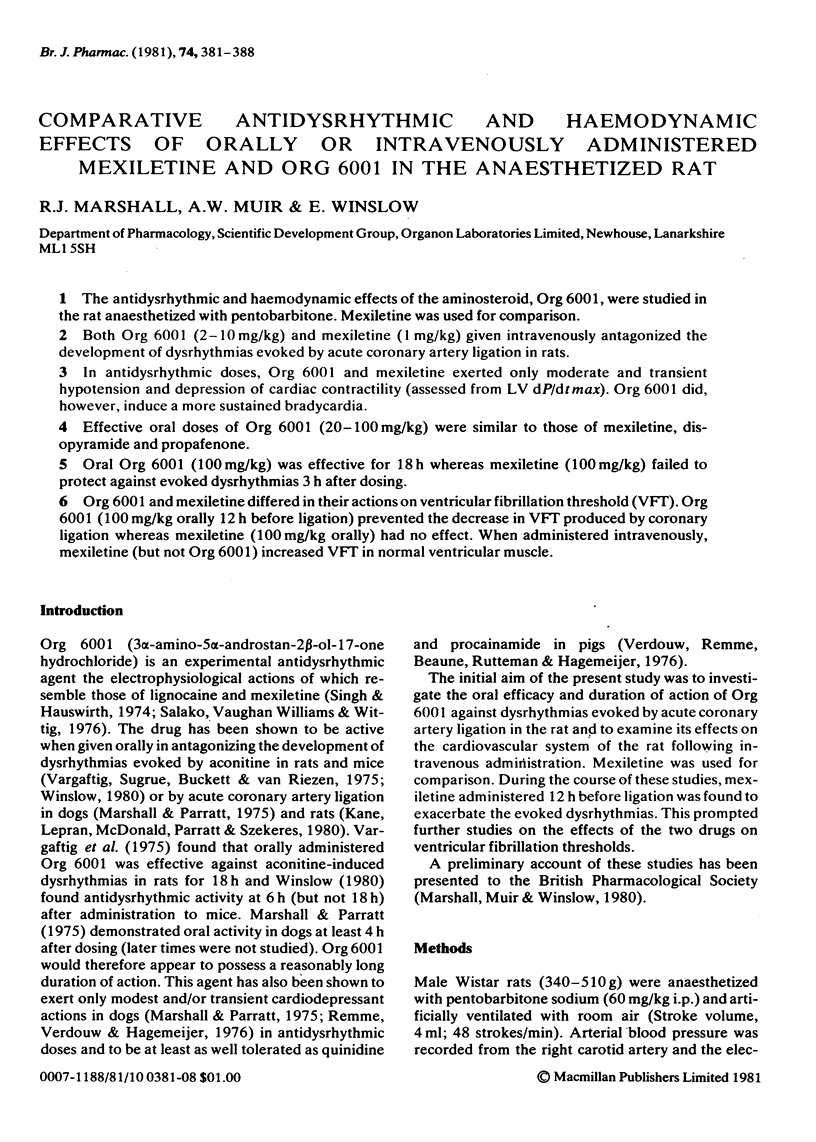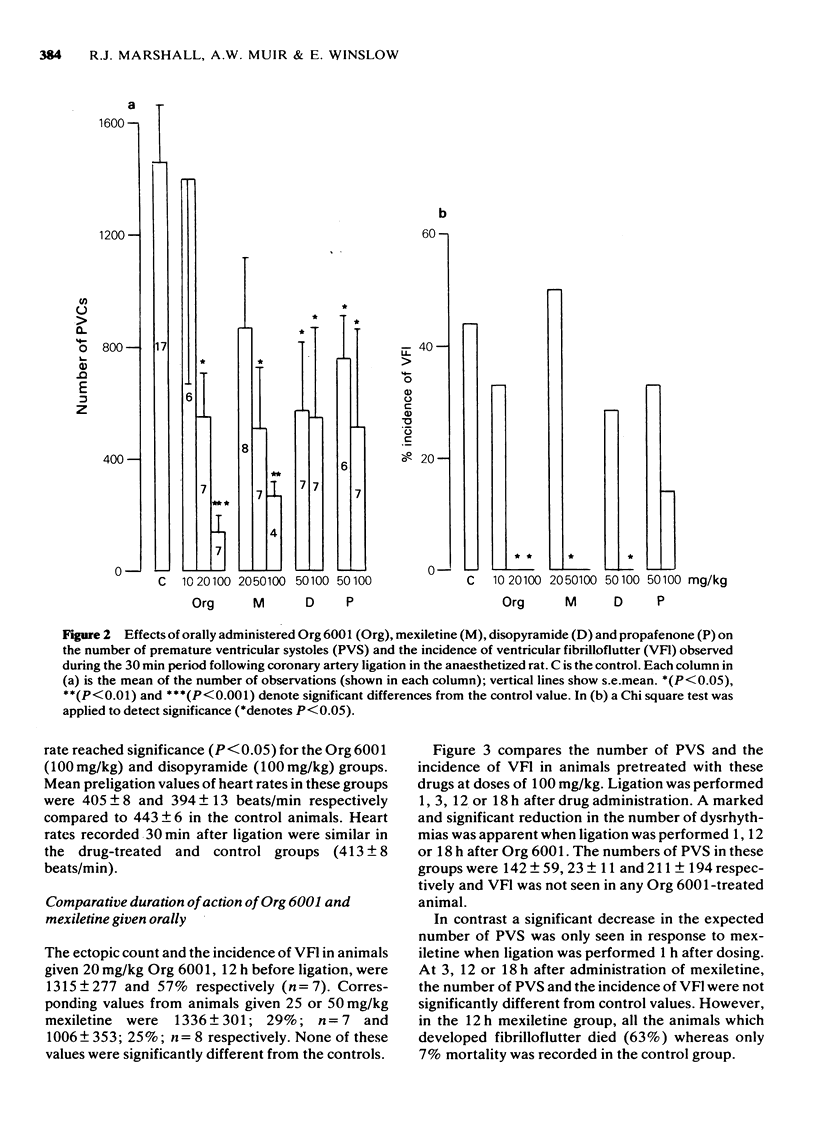Abstract
1 The antidysrhythmic and haemodynamic effects of the aminosteroid, Org 6001, were studied in the rat anaesthetized with pentobarbitone. Mexiletine was used for comparison. 2 Both Org 6001 (2--10 mg/kg) and mexiletine (1 mg/kg) given intravenously antagonized the development of dysrhythmias evoked by acute coronary artery ligation in rats. 3 In antidysrhythmic doses, Org 6001 and mexiletine exerted only moderate and transient hypotension and depression of cardiac contractility (assessed from LV dP/dtmax). Org 6001 did, however, induce a more sustained bradycardia. 4 Effective oral doses of Org 6001 (20--100 mg/kg) were similar to those of mexiletine, disopyramide and propafenone. 5 Oral Org 6001 (100 mg/kg) was effective for 18 h whereas mexiletine (100 mg/kg) failed to protect against evoked dysrhythmias 3 h after dosing. 6 Org 6001 and mexiletine differed in their actions on ventricular fibrillation threshold (VFT). Org 6001 (100 mg/kg orally 12 h before ligation) prevented the decrease in VFT produced by coronary ligation whereas mexiletine (100 mg/kg orally) had no effect. When administered intravenously, mexiletine (but not ORg 6001) increased VFT in normal ventricular muscle.
Full text
PDF







Selected References
These references are in PubMed. This may not be the complete list of references from this article.
- Allen J. D., Ekue J. M., Shanks R. G., Zaidi S. A. The effect of Kö 1173, a new anticonvulsant agent on experimental cardiac arrhythmias. Br J Pharmacol. 1972 Aug;45(4):561–573. doi: 10.1111/j.1476-5381.1972.tb08114.x. [DOI] [PMC free article] [PubMed] [Google Scholar]
- Arita M., Goto M., Nagamoto Y., Saikawa T. Electrophysiological actions of mexiletine (Kö1173) on canine Purkinje fibres and ventricular muscle. Br J Pharmacol. 1979 Sep;67(1):143–152. [PMC free article] [PubMed] [Google Scholar]
- Bigger J. T., Jr, Bassett A. L., Hoffman B. F. Electrophysiological effects of diphenylhydantoin on canine purkinje fibers. Circ Res. 1968 Feb;22(2):221–236. doi: 10.1161/01.res.22.2.221. [DOI] [PubMed] [Google Scholar]
- Clark C., Foreman M. I., Kane K. A., McDonald F. M., Parratt J. R. Coronary artery ligation in anesthetized rats as a method for the production of experimental dysrhythmias and for the determination of infarct size. J Pharmacol Methods. 1980 Jun;3(4):357–368. doi: 10.1016/0160-5402(80)90077-7. [DOI] [PubMed] [Google Scholar]
- Kane K. A. Comparative electrophysiological effects of Org 6001, a new orally active antidysrhythmic agent, and lignocaine on human ventricular muscle. Br J Pharmacol. 1980 Jan;68(1):25–31. doi: 10.1111/j.1476-5381.1980.tb10695.x. [DOI] [PMC free article] [PubMed] [Google Scholar]
- Kane K. A., Leprán I., McDonald F. M., Parratt J. R., Szekeres L. The effects of prolonged oral administration of a new antidysrhythmic drug (Org 6001) on coronary artery ligation dysrhythmias in conscious and anesthetized rats. J Cardiovasc Pharmacol. 1980 Jul-Aug;2(4):411–423. doi: 10.1097/00005344-198007000-00008. [DOI] [PubMed] [Google Scholar]
- Marshall R. J., Parratt J. R. Antiarrhythmic, haemodynamic and metabolic effects of 3alpha-amino-5alpha-androstan-2beta-ol-17-one hydrochloride in greyhounds following acute coronary artery ligation. Br J Pharmacol. 1975 Nov;55(3):359–368. doi: 10.1111/j.1476-5381.1975.tb06939.x. [DOI] [PMC free article] [PubMed] [Google Scholar]
- Remme W. J., Verdouw P. D., Hagemeyer F. Antiarrhythmic and hemodynamic effects of an aminosteroid (Org 3001) in the digitalized dog. Eur J Pharmacol. 1976 Mar;36(1):189–197. doi: 10.1016/0014-2999(76)90271-5. [DOI] [PubMed] [Google Scholar]
- SELYE H., BAJUSZ E., GRASSO S., MENDELL P. Simple techniques for the surgical occlusion of coronary vessels in the rat. Angiology. 1960 Oct;11:398–407. doi: 10.1177/000331976001100505. [DOI] [PubMed] [Google Scholar]
- Salako L. A., Williams V., Wittig J. H. Investigations to characterize a new anti-arrhythmic drug, ORG 6001 including a simple test for calcium antagonism. Br J Pharmacol. 1976 Jun;57(2):251–262. doi: 10.1111/j.1476-5381.1976.tb07475.x. [DOI] [PMC free article] [PubMed] [Google Scholar]
- Singh B. N., Hauswirth O. Comparative mechanisms of action of antiarrhythmic drugs. Am Heart J. 1974 Mar;87(3):367–382. doi: 10.1016/0002-8703(74)90080-5. [DOI] [PubMed] [Google Scholar]
- Vargaftig B. B., Sugrue M. F., Buckett W. R., van Riezen H. ORG 6001 (3alpha-amino-5alpha-androstan-2beta-ol-17-one hydrochloride), a steroidal anti-arrhythmic agent. J Pharm Pharmacol. 1975 Sep;27(9):697–699. doi: 10.1111/j.2042-7158.1975.tb09535.x. [DOI] [PubMed] [Google Scholar]
- Verdouw P. D., Remme W. J., Beaune J., Rutteman A. M., Hagemeijer F. Cardiovascular effects of an antiarrhythmic aminosteroid ORG 6001 in the anesthetized pig. Arzneimittelforschung. 1976;26(8):1558–1561. [PubMed] [Google Scholar]
- Winslow E. Evaluation of antagonism of aconitine-induced dysrhythmias in mice as a method of detecting and assessing antidysrhythmic activity. Br J Pharmacol. 1980;71(2):615–622. doi: 10.1111/j.1476-5381.1980.tb10981.x. [DOI] [PMC free article] [PubMed] [Google Scholar]
- Yamaguchi I., Singh B. N., Mandel W. J. Electrophysiological actions of mexiletine on isolated rabbit atria and canine ventricular muscle and purkinje fibres. Cardiovasc Res. 1979 May;13(5):288–296. doi: 10.1093/cvr/13.5.288. [DOI] [PubMed] [Google Scholar]
- Zipes D. P., Troup P. J. New antiarrhythmic agents: amiodarone, aprindine, disopyramide, ethmozin, mexiletine, tocainide, verapamil. Am J Cardiol. 1978 May 22;41(6):1005–1024. doi: 10.1016/0002-9149(78)90853-6. [DOI] [PubMed] [Google Scholar]


